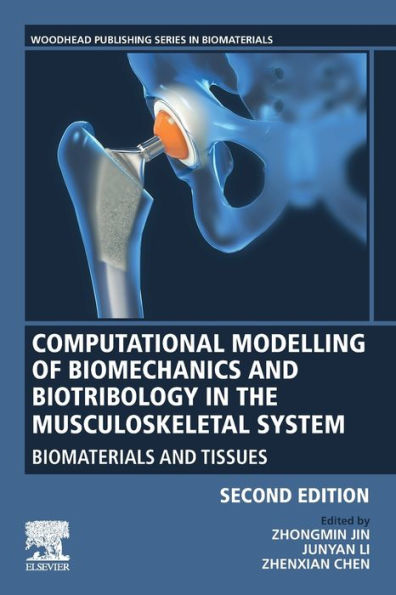Table of Contents
Contributor contact details xi
Woodhead Publishing Series in Biomaterials xv
Foreword xxi
Preface xxiii
Part I Generic modelling of biomechanics and biotribology 1
1 Fundamentals of computational modelling of biomechanics in the musculoskeletal system Z. Jin, Xi'an Jiaotong 3
1.1 Computational approach and its importance 3
1.2 Generic computational approach and important considerations 7
1.3 Computational methods and software 8
1.4 Future trends 8
1.5 Sources of further information and advice 9
1.6 References 10
2 Finite element modeling in the musculoskeletal system: generic overview L. Ren Z. Qian 12
2.1 The musculoskeletal (MSK) system 12
2.2 Overview of the finite element (FE) method 14
2.3 State-of-the-art FE modeling of the MSK system 16
2.4 Key modeling procedures and considerations 21
2.5 Challenges and future trends 25
2.6 References 27
3 Joint wear simulation M. Strickland M. Taylor 39
3.1 Introduction 39
3.2 Classification of wear 40
3.3 Analytic and theoretical modelling of wear 41
3.4 Implementation of wear modelling in the assessment of joint replacement 51
3.5 Validating wear models 64
3.6 Future trends 66
3.7 References 69
3.8 Appendix: useful tables 76
Part II Computational modelling of musculoskeletal cells and tissues 91
4 Computational modeling of cell mechanics M. L. Rodriguez N. J. Sniadecki 93
4.1 Introduction 93
4.2 Mechanobiology of cells 94
4.3 Computational descriptions of whole-cell mechanics 100
4.4 Liquid drop models 100
4.5 Solid elastic models 107
4.6 Power-law rheology model 109
4.7 Biphasic model 111
4.8 Tensegrity model 113
4.9 Semi-flexible chain model 115
4.10 Dipole polymerization model 116
4.11 Brownian ratchet models 118
4.12 Dynamic stochastic model 121
4.13 Constrained mixture model 122
4.14 Bio-chemo-mechanical model 125
4.15 Computational models for muscle cells 128
4.16 Future trends 130
4.17 References 132
5 Computational modeling of soft tissues and ligaments M. Marino G. Vairo 141
5.1 Introduction 141
5.2 Background and preparatory results 142
5.3 Multiscale modeling of unidirectional soft tissues 146
5.4 Multiscale modeling of multidirectional soft tissues 158
5.5 Mechanics at cellular scale: a submodeling approach 164
5.6 Limitations and conclusions 166
5.7 Acknowledgments 168
5.8 References 169
6 Computational modeling of muscle biomechanics T. Siebert C. Rode 173
6.1 Introduction 173
6.2 Mechanisms of muscle contraction: muscle structure and force production 175
6.3 Biophysical aspects of skeletal muscle contraction 177
6.4 One-dimensional skeletal muscle modeling 184
6.5 Causes and models of history-dependence of muscle force production 188
6.6 Three-dimensional skeletal muscle modeling 191
6.7 References 195
7 Computational modelling of articular cartilage L. P. Li S. Ahsanizadeh 205
7.1 Introduction 205
7.2 Current state in modelling of articular cartilage 211
7.3 Comparison and discussion of major theories 220
7.4 Applications and challenges 228
7.5 Conclusion 233
7.6 References 234
8 Computational modeling of bone and bone remodeling H. Gong L. Wang M. Zhang Y. Fan 244
8.1 Introduction 244
8.2 Computational modeling examples of bone mechanical properties and bone remodeling 245
8.3 Results of computational modeling examples 257
8.4 Conclusion and future trends 260
8.5 Sources of further information and advice 265
8.6 Acknowledgments 265
8.7 References 265
9 Modelling fracture processes in bones A. Abdel-Wahab S. Li V. V. Silberschmidt 268
9.1 Introduction 268
9.2 A brief update on the literature 269
9.3 Physical formulation and modelling methods 273
9.4 Results and discussion 285
9.5 Challenges, applications and future trends 298
9.6 Sources of further information and advice 299
9.7 Acknowledgement 299
9.8 References 300
Part III Computational modelling of orthopaedic biomaterials and interfaces 303
10 Modelling fatigue of bone cement A. B. Lennon 305
10.1 Introduction 305
10.2 Modelling fatigue of bulk cement 308
10.3 Cement-implant interface 315
10.4 Cement-bone interface 316
10.5 Current and future trends 317
10.6 Conclusion 324
10.7 References 324
11 Modelling fracture processes in orthopaedic implants S. Stach 331
11.1 Introduction 331
11.2 The fracture mechanics approach 332
11.3 Mechanical properties 334
11.4 Determination of fracture mechanics parameters 342
11.5 Overview of computer methods used in mechanics 350
11.6 Simulation and modelling of the crack path in biomaterials 357
11.7 Challenges and future trends 365
11.8 References 366
12 Modelling cementless cup fixation in total hip arthroplasty (THA) C. Schulze C. Zietz R. Souffrant R. Badhr D. Kluess 369
12.1 Cup fixation in acetabular bone stock 369
12.2 Measurement and numerical analysis of cup fixation 371
12.3 Summary of the relevant literature 373
12.4 Materials and assumptions 374
12.5 Modelling methods and details 378
12.6 Understanding and interpretation 382
12.7 Challenges, applications and future trends 383
12.8 References 384
Part IV Applications of computational modelling for joint replacements and tissue scaffolds 387
13 Computational modeling of hip implants J. Geringer, École L. Imbert, École K. Kim 389
13.1 Introduction 389
13.2 Modeling and methods 391
13.3 Results 396
13.4 Discussion 406
13.5 Future trends 411
13.6 Conclusion 412
13.7 References 413
14 Computational modelling of knee implants J. H. Muller 417
14.1 Introduction 417
14.2 Application of computational models in analysis of knee implants 424
14.3 Assumptions for kinematics and kinetics 426
14.4 Model definition 428
14.5 Model formulation 432
14.6 Model solution 435
14.7 Model validation 438
14.8 Conclusion, challenges and future trends 442
14.9 Sources of further information and advice 443
14.10 References 443
15 Computational modelling of spinal implants J. Noailly A. Malandrino F. Galhusera 447
15.1 Introduction 447
15.2 Spine and implant computational biomechanics 449
15.3 Numerical assessments of spinal implants 458
15.4 Future trends 467
15.5 Conclusion 473
15.6 References 474
16 Finite element modelling of bone tissue scaffolds A. Boccaccio A. Messina C. Pappalettere M. Scaraggi 485
16.1 Introduction 485
16.2 Fundamentals of computational mechanobiology 490
16.3 Applications of finite element modelling (FEM) and computational mechanobiology to bone tissue engineering 496
16.4 Discussion 504
16.5 Conclusions and future trends 507
16.6 References 507
Index 513



